In Touch In Touch Touch In Touch Touch In Touch Touch In Touch In Touch Touch In Touch Touch
NORTHERN CLAY CENTER PRESENTS
MARCH 15 – MAY 25, 2025
NORTHERN CLAY CENTER
MINNEAPOLIS, MINNESOTA

MARCH 15 – MAY 25, 2025
NORTHERN CLAY CENTER
MINNEAPOLIS, MINNESOTA
© 2025 Northern Clay Center. All rights reserved.
No part of this book may be used or reproduced in any manner whatsoever without written permission, except in the case of brief quotations embodied in critical articles and reviews.
For information, write to: Northern Clay Center 2424 Franklin Avenue East Minneapolis, MN 55406
www.northernclaycenter.org
Manufactured in the United States
First edition, 2025
International Standard Book Number 978-1-932706-70-4
Unless otherwise noted, all dimensions in inches: height precedes width precedes depth.
In Touch showcases a group of artists who engage with and utilize notions of touch from a broad perspective: through the core act of forming and leaving one’s imprint, to the broader implications of agency within the material and meaning accruing within a process. Material exploration and critical engagement move through multiple approaches and frames of reference, all with a distinct position regarding how touch informs all of our senses. This exhibition brings together distinct objects, transient actions, and work created on site and with the collaborative action of the audience. Occurring in clay’s multiple states, from the transient to the geologic, this exhibit seeks to actualize the unique potential of ceramics through the language of touch to engage with ideas.
Touch connects the physical to the emotional, the individual to the collective, and the real to the metaphorical. As an act, it transcends mere contact; it is a conduit through which we understand our own humanity. Touch evokes intimacy, power, vulnerability, and knowledge. It is the very means by which we shape our experience and leave our mark on the world.
The Phenomenology of Touch:
In touch we find each other. In touch means to be connected to someone, to communicate with them to be connected. In touch suggests someone who is aware, in touch with an idea.
In touch exists within this thing we call touch.
In this exhibition, we experience artists who are engaged in the work of critical intelligence. But these artists also commit to work that honors and amplifies the importance of physical intelligence. A kind of noticing that goes beyond the simply analytical. Touch is often described, loosely as a term, flowing around our analysis of an artwork, with a particular emphasis in ceramics. As a term, “touch” often sits too easily within our description of a work. Our use of words like “touch” serve as loose qualifiers of what makes a work good or bad, valid or invalid. In ceramics, we often fetishize the language of touch, without exploring intelligently our understanding of the term’s complexities.
In deciding on this curatorial approach, I thought to take a word, a quality that is often overused as a unique and important characteristic of ceramics, and instead of negating it, amplify it further. Exploring it as a way to pursue touch as a multivalent concept, one that slips between many ways of thinking and exploring ideas, agency, social, and political issues.
At its core, touch is an act of contact, an intersection of bodies and worlds. It’s the most primal of our senses, one that is deeply ingrained in both human development and social interaction. Through touch, we are shaped and reshaped; we become conscious of our own bodies, of others, and of the environments we inhabit. In In Touch, the artists explore the complexity of this sensory experience, moving beyond the simple act of touching to examine the deeper meanings that touch evokes.
Touch is both passive and active, a dynamic exchange that moves between giving and receiving. There is a subtle difference between being touched and actively touching something. When we reach out to make contact, we project ourselves into the world, while when we are touched, we receive the world’s presence into our bodies. This distinction is crucial in understanding how touch informs our perception of both ourselves and the world around us.
This act of touching extends beyond the tactile. The physicality of touch is inseparable from the mental and emotional act of making. But touch is not just this familiar space, it is also an exploration of identity, power, history, and memory. Touch becomes a metaphor for engagement with the world and the processes through which we navigate both the personal and the collective.
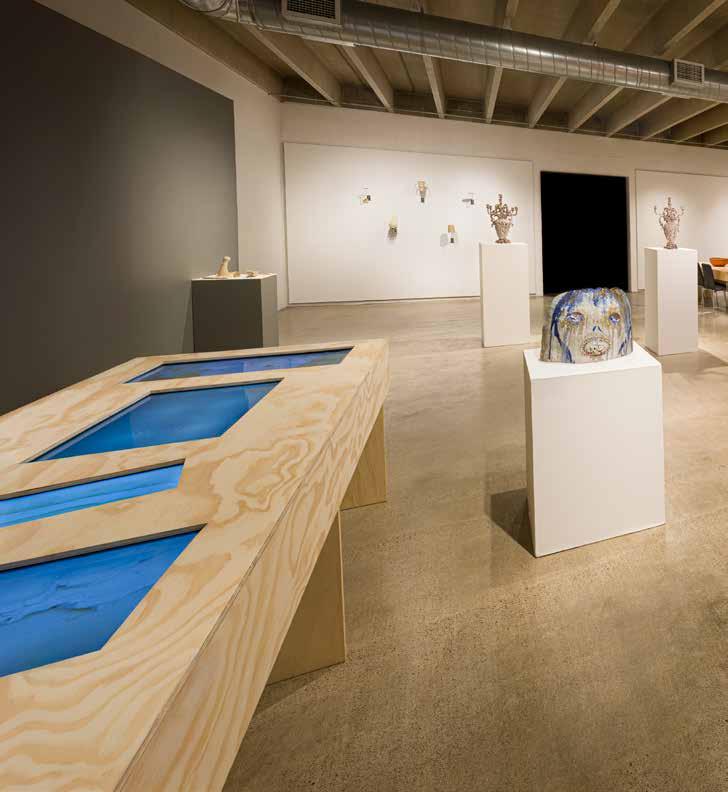

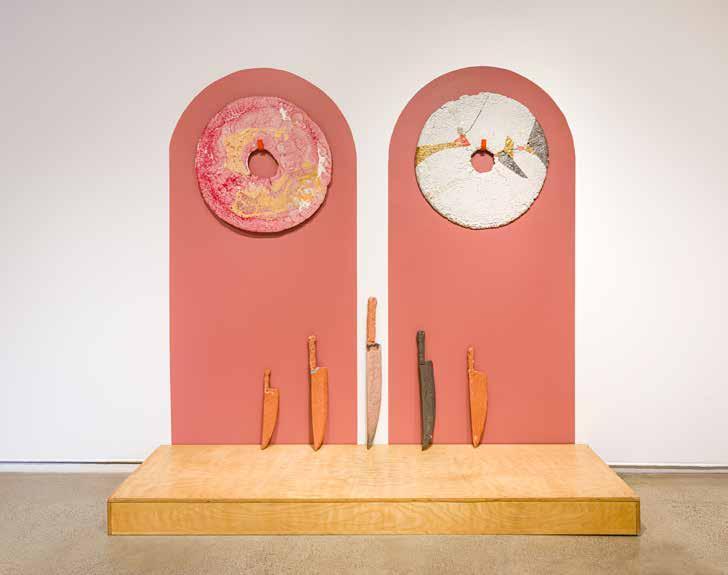
Renata Cassiano Alvarez, is the daughter of archeologists. This is revealing in regards to the way it shapes her work and arguably her worldview. Her references shift between histories and methods of display; her processes utilize the material as a full collaborator, recognizing and honoring the material’s own agency. In Cassiano Alvarez’s work, human existence is not privileged over the existence of nonhuman objects. In this work, we find ourselves in a Mexican kitchen and in an anthropological museum; we see a form in a state between becoming and erasure. Architecture is actively used and referenced for what it means to our undertaking of objects, their identity, histories, and our own understanding of them.
Engaged in a kind of pre-Hispanic exploration, Cassiano Alvarez explores her work as an animist–materials are a contact for a relationship in which an entity is found, understood, and then re-found over and over again. In one signature series, Cassiano Alvarez’s works are quite literally found. Utilizing mold processes as a way of establishing a barrier, Cassiano Alvarez’s work will grow as the artist pursues a repeated gesture, a mark, that
accumulates as forms are added to the mold. The sculpture becomes itself, now found anew as the mold is taken apart. In this, Cassiano Alvarez’s work is a dialogue between maker and material. The material has political agency; it is a partner, not an inert mass to be acted upon.
Cassiano Alvarez’s objects are often pared down as a way of understanding or finding a core idea. She creates as a way to understand when a thing is no longer itself, like a “dandelion when you blow, what core remains” (Cassiano Alvarez). How does something maintain its integrity, and at what point in erasure does something change?
She describes her objects as “entities that have many lives”; they duplicate and separate just as we transform and move on. The work becomes different things in different places. The importance of context, and how it creates and muddies meaning, is an active axis within Cassiano Alvarez’s work and our enlivened sense of all things in our experience of it.
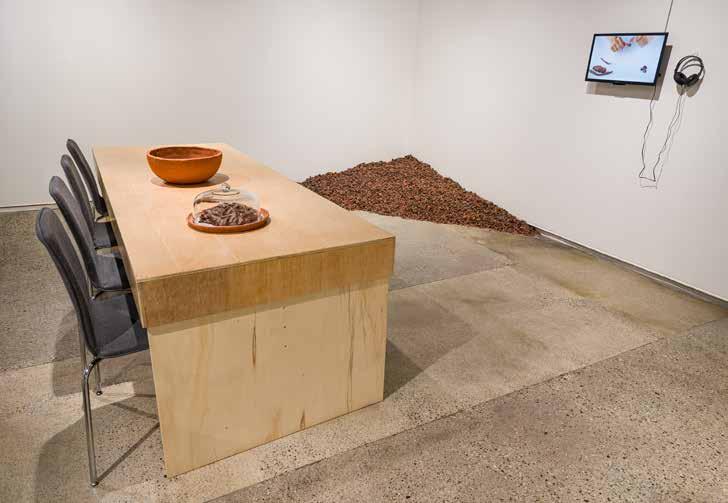
Magdolene Dykstra
Exchanging Presence, 2022–Ongoing
Hundreds of pounds of small ceramic remnants, glazed terracotta, glass cover, ceramic bowl
Magdolene Dykstra’s work for the past many years has focused primarily on site-based works, utilizing the use of raw clay to explore the tension and connection between the individual and the group. The generosity of her recent projects, and the brand-new piece that is part of In Touch, graciously lends its focus to a work’s potential to activate a collective and to actively make space for people as viewers and participants with the intent of forefronting collective care. Clay is used as both a real and metaphorical material simultaneously, as viewers and participants pull from the same raw clay “body” to create remnants that become a record of each individual. By inviting the audience to engage in recording themselves with clay in the gallery, Dykstra’s work becomes everyone’s— the collective’s—while also maintaining itself as a source. Structures of care drive Dykstra’s work—how is care expressed, where is it expressed, how can it be more the animating force of one’s creative work, and how can it become the central value expressed through the piece and our experience of it?
Dykstra’s recent work has moved between raw clay landscapes, a form language that speaks of a search for place within the world. These works inhabit and overtake other forms, including the gallery itself. A signature of Dykstra’s is also the use of the fingerprint, first with works utilizing ceramic oxides and patterns made on the wall, one fingerprint at a time, and now with the material of clay itself. The fingerprint: the repeated mark of the individual in the formation of an expansive ephemeral wall piece.
In Touch presents several of Dykstra’s elements coming together through two interactive sites: one that focuses on an exchange of “presence” and the
giving of collective care and one that offers a zeer pot stand where the audience is invited to wash their hands. Zeer is a new introduction to Dykstra’s work that pulls from a uniquely Egyptian vessel form that is archaic (dating back to 2500 BC) and is also integrated into contemporary life. The touch of human beings in this work is individual but also universal. This recording of touch has extended to works that invite the viewer to engage in the creation of what Dykstra refers to as a “remnant”. Each “user” in the gallery pulls from one source and records their touch in a small shard. These small gestures are left behind and accumulate; eventually, they are fired and then return to the source of the artist for their next incarnation. Through these new works, the power of the collective becomes the key driver of the work as the touch of many combines into one. In Dystra’s work, each individual is recorded through the collection of traces—in the fingerprint captured in a shard, or in the residue of washing their hands of clay. The audience becomes a body of its own in the work as the residue of touch accumulates. Through the use of a washing station in the gallery, Dykstra introduces us to the archaic form of the zeer. These vessels, which are an active and unique part of Egyptian culture, continue to serve all people with the generosity of fresh water. These works tie a kind of social care to the technical capacity of terracotta to both contain and keep water cool through evaporation. They speak to the way in which clay is inexorably linked to human evolution. Egypt’s incredible water-sharing tradition drives Dykstra’s installation, extending it in this new context. Through a kind of empathetic criticality, Dykstra’s work is deeply felt and engages in a new form of institutional critique. The generosity of an archaic gesture made newly manifest.
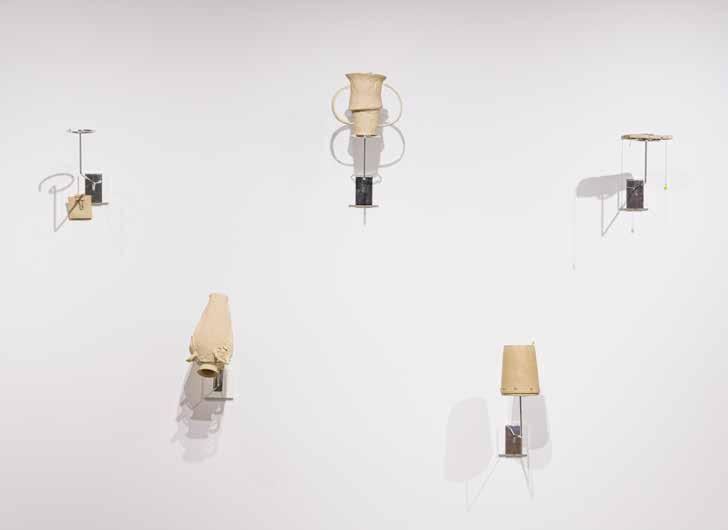
Local clay, stoneware, glaze, platinum luster, chrome sport-ball/helmet display, chrome milliner’s display
87 x 67 x 12
Notions and reminders of our precarity exist within and around the work of Sam Mack. Mack’s work actively seeks to humanize and critique institutional power through sometimes subtle means. Impressing on the viewer, familiar objects are recontextualized and remade as a way of study or celebration. Chains act both as systems of adornment on the clay objects as well as formal visual links between things. They offer a bit of bling to a tender and tenacious vessel; they suggest a connection sometimes through its absence. Lovingly rendering the charged everyday through nontraditional means, Mack’s work creates beauty while also making something “wrong” (breaking clay rules of building and firing, encouraging cracks and fissures) to question the arbitrary nature through which we judge and understand beauty. The work riffs on the tender relationship between an object and its site; it subverts formal systems of display but does so with exquisite attention to detail obfuscating how we understand importance and power. Mack’s work forefronts the truth of the objects of our lives and explores “the vessel as allegorical device and politicized form” (Mack). Often precarious, both in their making and their relationship to site, Mack’s work reminds us of our own precarity and those who are overlooked, silenced, and put at risk. The body is present in the work only in its absence. Something that was there briefly, the creator of this residue is now gone, leaving behind the strangely sensuous residue of their personal day-to-day. The strap, the handle, and the piss cup, forms slip between the functional quotidian and curious, poetic ephemera.
As we see a renewed interest in ceramics with both art and technical contexts, there has been a distinct interest in the abject materiality of glaze—gloopy, drippy, viscous color that is out of control, often becoming more of the work than the clay that supports it. Against this backdrop, it is fascinating to see Mack’s work taking an aggressively “naked” approach. In this, the work is distinctly brave with nothing to hide behind (or from). The materiality of the image is in the “buff”, both a color and a pun (nudity, someone who is strong or “swol”). The humor in this work is both a salve and an entrance point through which we slowly become acutely aware of the trans body under surveillance.
In Mack’s work, we find an exploration of the castoff, the mundane, the ephemera of a daily routine that is habitual but also inexorably and critically attached to who we are and the way we navigate the world. As much as Mack’s work explored the familiar object of the cast-off cup, lovingly rendered as a form of study and understanding, yet “made wrong” as a way of questioning how a thing comes into being. Mack’s work explores where an idea sits and how ceramics has a unique role to play through its connection with our history. Here, the body becomes visible through the ephemera. The collected debris of our lives is revealed to include hormonal shot cartridges (hormone replacement therapy), the legacy transition, and care of the transgender body.

One of the more unique aspects of clay and one of the key parts of its behavior that makes it so important for humans is its capacity to go from soft, squishy, and malleable to hard, rock-like, and vitreous. In this transformation, the soft becomes hard, the languid squish becomes sharp, and the once receptive malleable material becomes like glass. In Paige O’Toole’s work, the fecundity and generosity of the pinched clay become fragile, sharp, and dangerous. This duality engages with the complexities of decorative objects and images of power to push on cultural and political issues through works that are gorgeous and alluring, while also sometimes being disturbing in their intense haptic energy.
Hovering around the line of “decadence and decay,” O’Toole creates objects of amazing activity and power despite their scale. Like pieces of decorative baroque furniture coming into focus through the accumulation of active lines of energy, these sometimes familiar decorative images (a chair, a frame, a clock) fuzz in and out of focus by the sheer energy of their making. This activity is contained, often within an image redolent of histories of ornament, but also in the classicism of bilateral symmetry. Through this, O’Toole then reminds us of the very systems of formal organization and the power they have to create a system of control.
O’Toole speaks at length about these themes and the presence of “duality” within the work, beauty and the grotesque, being and becoming, the once subtle soft and squishy now made into stone, into glass. Her work seeks the sensuous, the excess, and revels in it while being aware of its danger and weight.
O’Toole’s ceramic work explores the delicate balance between beauty and decay, and the contradictions embedded in our desire. Certainly, touch is explicit in O’Toole’s work, leaving behind traces that carry the memory of the maker. The clay holds the imprints of both care and force. O’Toole’s work challenges the viewer to reconsider their relationship with materiality, consumption, and the fragile boundaries between attraction and repulsion in the pursuit of excess.
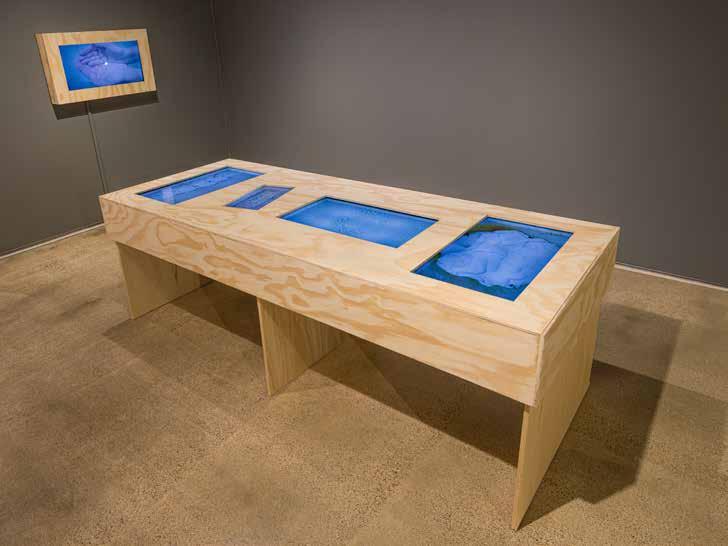
Nicole Seisler’s projects extend through making, curating, organizing, exhibiting, and documenting, all with the same sense of wonder and openness to where and when meaning occurs. Through a distinct and timely understanding of clay’s unique potential to capture and explore nuanced and complex ideas, not just through the historical structure of technical skill, but through careful and deep attention, Seisler’s work is deceptively but purposely simple. Her work sits in a deeply personal place that is also political, exploring access, equity, what it means to be an artist, and where art is. Her work is more about shifting the dialogue around what ceramics is than being concerned with traditional perspectives on mastery and technique.
In this exhibition, Seisler’s work explores the site of video to record her interactions with clay and other elements: stone, water, and light, to continue this deeply poetic exploration as the body interacts with the world around it. Materials and the way they allow us to explore core metaphors around the human condition are the focus. Interestingly, the remoteness of our pandemic world has only strengthened the timeliness and physical intelligence of Seisler’s work. A project that fuses making, curating, and educating is all the more palpably important in the context of a world forced to build relationships remotely. Newer
video works of Seisler’s in the exhibit exist as both an exploration of light as a medium as well as an exploration of the behavior of light itself. Smaller works exist on screens exhibited in the gallery as objects or embedded in their systems of display.
Seisler’s ceramic work often challenges conventional narratives, instead prioritizing a deep attentiveness to the material’s inherent potential. Through video installations and site-specific pieces, Seisler captures the interaction between her hands and the clay, turning the act of making into a performative exploration of light, water, stone, and body. Her work speaks to the fleeting nature of touch—the way in which a hand’s contact with clay can leave behind not just a physical imprint but a metaphorical one, a trace of the body’s presence in the world.
For Seisler, ceramics is an ongoing process of investigation, a means of exploring access, equity, and the power of human connection. Her work is deeply political, asking us to reconsider the systems through which art is made, valued, and consumed. Her touch on the material becomes an act of resistance—an assertion of the artist’s agency in a world that often seeks to silence or marginalize.
In Touch is an exhibition that invites us to consider the many dimensions of touch. The work of these five artists asks us to think beyond the physical act of contact and to explore the ways in which touch shapes our bodies, our histories, and our identities. In ceramics, touch is both an intimate and collective experience—an act of creation, destruction, and transformation. These works ask us to reconsider our relationship to the material world, to the social systems that govern us, and to the delicate, powerful ways in which we touch one another.
Through clay, we touch time, culture, and memory. Through these artists, we touch the world in ways that are both personal and universal, tender and fierce. And through this touch, we find connection—a connection to the past, to the present, and to each other.
In a time of politics and acceleration, artists stand in a unique position to mediate the complexities of the human experience, offering both resistance and reflection through the tactile act of making. Artists possess the power to challenge, to question, and to reimagine the ways in which we engage with the world, using touch as a form of active resistance against the disembodiment of contemporary life. Through their work, they offer us a touchstone—an invitation to slow down, to feel, to be present in our bodies and in our world. The act of touch becomes a tool for solidarity, collective care, and reclaiming agency in an age of disconnection. It is through touch that we shape and are shaped, that we leave marks and are marked, that we create meaning and are transformed by it. In Touch invites us to pause, to reflect, and to feel the world anew through the embodied power of touch.
Northern Clay Center’s mission is to advance the ceramic arts for artists, learners, and the community, through education, exhibitions, and artist services. Its goals are to create and promote high-quality, relevant, and participatory ceramic arts educational experiences; cultivate and challenge ceramic arts audiences through extraordinary exhibitions and programming; support ceramic artists in the expansion of their artistic and professional skills; embrace makers from diverse cultures, experiences, and traditions in order to create a more inclusive clay community; and excel as a non-profit arts organization.
Exhibition Staff
Maria Hennen, Galleries Coordinator
Tippy Maurant, Deputy Director/ Director of Galleries & Exhibitions
Jasa McKenzie, Exhibition Manager
Kyle Rudy-Kohlhepp, Executive Director
The exhibition program is part of a team that excels in supporting one another, so we gratefully acknowledge every staff person who contributed to the success of In Touch.
Board of Directors
Mary K. Baumann, Chair
Evelyn Weil Browne, Vice Chair
Lisa M. Agrimonte
James Ebner
Frank Fitzgerald
Michael Karels
Patrick Kennedy
Kate Maury
Debbie Schumer
Ramon Serrano
Honorary Director
Kay Erickson
Legacy Directors
Andy Boss
Warren MacKenzie
Joan Mondale
Directors Emeriti
Emily Galusha
Sarah Millfelt